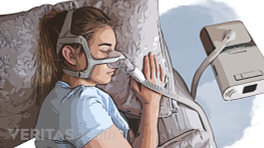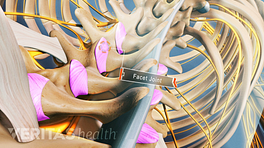Periods of rest and inactivity can aggravate your ankylosing spondylitis symptoms. This makes sleeping a challenge, as the longer you’re in bed the more pain you may experience.
If you’re tired of being tired, try these 3 tips for sleeping with ankylosing spondylitis:
Sleep on your back to ease ankylosing spondylitis symptoms
Many people find relief from their ankylosing spondylitis symptoms by sleeping on their back. I tell my patients that the key to sleeping in this position is to maintain the natural curvature of their spine.
Here are a few pointers if you want to give it a try:
- Avoid a large head pillow. Elevating your neck distorts your spine and can provoke joint pain. Your best option is typically to sleep without a pillow, but if that won’t work for you try purchasing a slim pillow or using a folded towel. In general, you should also avoid tucking pillows under your back or legs.
- Be persistent. If you’re like most people, you prefer to sleep on your stomach or side. Switching to sleeping on your back may feel awkward at first—but don’t give up after only a few nights. Try it for 2 weeks, and if you still can’t fall asleep then experiment with other sleep positions until you find one that works for you.
- Purchase a new mattress. Innerspring mattresses often sag as they age—resulting in uneven sleeping surfaces. Do your spine a favor by purchasing a new mattress every 5-7 years, or if your mattress is showing any signs of sagging. You can easily spot sagging areas by taping a piece of taut string across your bed.
As a general rule, a firm mattress is best for people with ankylosing spondylitis. But every person is different, so make sure to visit a mattress store and try out a variety of options. It’s also a smart idea to purchase a mattress with a 30-day return policy in case your new mattress proves to not be as comfortable as you first thought.
See Ankylosing Spondylitis Treatment
Leave your bed if you can’t fall asleep
You can’t force yourself to fall asleep, and staying in bed will likely increase your stress and further aggravate your ankylosing spondylitis symptoms. So, while it may seem counterintuitive, I suggest you get out of bed if you can’t fall asleep within 30 minutes.
See Coping with Chronic Pain and Insomnia
Instead of brooding for hours, engage in a relaxing activity until you feel sleepy. For example, you might try:
- Reading a book
- Knitting or crocheting
- Completing a crossword puzzle
- Listening to calming classical music
See Therapies for Treating Insomnia
Remember that certain activities can make it harder to fall asleep, so when you get out of bed I suggest you avoid the following:
- Watching television or using your phone. The blue light from electronics can hinder your sleep by blocking the release of melatonin. Watching the news, texting, or checking Facebook can also overstimulate your brain and increase stress levels.
- Rigorous exercise. It’s true that certain exercises can relieve your ankylosing spondylitis pain, but rigorous exercise makes it hard to sleep by temporarily raising your heart rate, adrenaline levels, and body temperature. If you’re restless, one exercise option that can help you relax and relieve your pain is light stretching.
- Unhealthy eating. Certain foods—such as those containing sugar or high amounts of fat—can keep you awake. If you need to eat something, try a snack that contains protein and calcium—like a glass of milk.
Get checked for sleep apnea
A 2009 study found that people with ankylosing spondylitis are more likely to suffer from obstructive sleep apnea. 1 Rheumatology (2009) 48 (4): 433-435.doi:10.1093/rheumatology/kep021First published online: February 17, 2009. This means that your sleep problems may not be due to your ankylosing spondylitis symptoms. Rather, your airway may be restricted—which leads to shallow or restricted breathing that can cause you to wake up constantly throughout the night.
If you’re always snoring, or if you notice frequent interruptions to your breathing during the night, consult with your doctor about sleep apnea. Sleep apnea is typically diagnosed by way of an overnight sleep study called a polysomnogram.
Common treatments for sleep apnea include:
- Weight Loss
- Quitting smoking
- A facemask connected to a CPAP machine (or continuous positive airway machine)
- A removable mouthpiece
See Ankylosing Spondylitis Physical Therapy and Exercise
These 3 tips may not alleviate all your ankylosing spondylitis symptoms, but even if they provide you with a few more hours of sleep per week they are worth the time and effort.
Learn more:
- 1 Rheumatology (2009) 48 (4): 433-435.doi:10.1093/rheumatology/kep021First published online: February 17, 2009.









